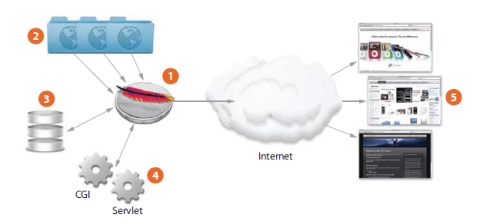Archive for the ‘oPiNiOn (“,)’ Category
WeB hOsTiNg AnD hOw It CoSt ???
Posted on: April 7, 2009
Web Hosting at a Glance

1) Provide reliable, high-performance web hosting with the built-in Apache web server.
2) Host multiple websites on a single server, using SSL and realm-based authentication to secure network transactions and control access to web content.
3) Link your site to a database using the included MySQL database; ODBC and JDBC database connectivity is also supported.
4) Generate dynamic server-side content with CGIs and Java Servlets.
5) Deliver web content and deploy enterprise Java applications to Internet clients with any standards-based browser.
Web Hosting – is a service which allocates space for customers to showcase their websites on computer servers that are connected to the Internet
Every server on the Internet has a unique numerical IP (Internet Protocol) address. You can think of servers as apartment buildings with unique addresses. Each apartment unit within each building is equivocal to space rented out for individual websites. And like real apartment buildings, each unit also has an address based on “the building” in which it is located. When you rent a space on a server then, you’re setting up house on the Internet. You can be reached by a unique address (the website address), which is based on the server’s address.
WEB HOSTING COST ?????
There are many different types of web hosting. Most packages come with certain capabilities for users. Examples are scripts that allow interactive functions, forms, bulletin boards and guest books. For professional purposes there are also Web hosting services that offer commercial packages that bundle business tools, like point of sales packages and credit card processing. Prices for Web hosting vary from free to hundreds of dollars a year, depending on your needs. Web hosting for personal websites that don’t require any special tools and have low traffic can be found easily for free.
Free Web hosting is convenient but has its drawbacks. Usually it will be required that you allow the server to run advertisements on your website. The advertisements are normally banner ads. Most free hosting services offer an alternative pay-plan to have the advertisements removed.
There are other considerations when looking for a Web host aside from price. Some hosting services have policies that restrict certain content, scripting languages, functions or uses. You should also read the privacy policy of any hosting service that you are considering, to see how they will use the personal information you provide to them in setting up your account.
So here are some web hosting info..so..try to click it
http://www.ntchosting.com/low-cost-affordable-shared-web-hosting.html
The amount of information we receive everyday through televisions, radios, and internet is increasing at unimaginable rate…huh…how UNIMAGINABLE RATE???? so great…..this possibilities also increase our knowledge and understanding.To build on what we already know however, requires critical thinking.
“Critical thinking is a common objective of various disciplines and a goal that most of us aspire”

Nowadays, we want students be able to examine logical relationship among statements of data, construct arguments, respect diverse perspectives, view phenomena from different points of view and have the flexibality to recast their thinking when reason leads them to do so. All of these activities need critical thinking.
Online discussion can engage students in a wide range of activities that contribute to intellectual growth such as they use chat or blog to share idea with each others in meaningful way…yup..such as activity we do now..commenting in friends blog….hm..so am i sharing my idea..hope so….(“,)
Here i want to share some information with all of u guys…
Collaborative Learning Enhances Critical Thinking
Promoting Critical Thinking Through Discussion
Online Discussion and Critical Thinking Skills
So…what you’re waiting for…lets start commenting friends’ blog to test your critical thinking..hehehe
yeah…hm what do you mean by instructional design???what are they for???So when Dr Zaida told us that are about 40 instructional design model..wow..dats a lot…So i know all about this design since 2 year when i’m taking my degree…Waterfall, ADDIE, ARCS, Hannafin and Peck and so many more..u know…sincerely before this i just know n understand it just for past my exam..then till i want to do my degree project..then i knew that it is so important…now it is really2 important…Actually i know most about Hannafin and Peck…why???? coz i use that model when i developing my website project in my degree…from my reading Hannafin and Peck model is good for who want to develop a website…hm…so i want to share with u some information about instructional design model….
INSTRUCTIONAL DESIGN MODEL FOR CONSTRUCTIVIST LEARNING
so lets read and explore all the instructional design (ID) model with lot of enjoyment and patience…yeah..gud luck..and the most important hope our group will decide which ID model we want to use..
The word “Web 2.0” become known on first conference in October 2004. It shows us the new version of WWW and it most focus on the changes of the software development. This changes happened because to stimulate the creativity, sharing the knowledge and the most important thing is the cooperation between the user. Web 2.0 doesn’t have a hard boundary, but rather, a gravitational core. It is also as a set of principles and practices that tie together a veritable solar system of sites that demonstrate some or all of those principles, at a varying distance from that core.

A "meme map" of web 2.0
Below show the different between Web 1.0 and Web 2.0 :
Web 1.0 Web 2.0
DoubleClick –> Google AdSense
Ofoto –> Flickr
Akamai –> BitTorrent
mp3.com –> Napster
Britannica Online –> Wikipedia
personal websites –> blogging
evite –> upcoming.org and EVDB
domain name speculation –> search engine optimization
page views –> cost per click
screen scraping –> web services
publishing –> participation
content management systems –> wikis
directories (taxonomy) –> tagging (“folksonomy”)
stickiness –> syndication
Tim O’Reilly, the leader of the 2004 conference, has classified Web 2.0 into 4 level which is
Level 0: Software that can be used Offline and Online. Examples: Mapquest, Yahoo! Local
and Google Maps.
Level 1: Software that can be function eventhough Offline and it can be upgrade when
Online. Examples: Google Docs and iTunes
Level 2: Software can be used Offline but better used Online Example: Flickr
Level 3: Software that can be used when have connection with Internet. No Offline. All
interaction occurs in WWW. Examples: eBay, Wikipedia, Perbankan, Blogger,
Joomla, and Mambo
aRe bLoGs gOoD 4 LeArNiNg ????
Posted on: January 10, 2009
How blogging can be used in classes??? i don’t know how effective it is because this is the first time i use it…but it quit interesting whereas everyone in my class are excited…But in my opinion there are many advantages using blog for learning….One of the advantages to blog is that it provides another place for students to ask questions, and those questions remain public…..One alternative is to ask students to comment each week in the comments of the course blog(“,)… At first, this may seem as onerous as allowing them to post, but that is not necessarily the case. If you look for large-audience blogs outside of education, it is not unusual for some posts to attract hundreds of comments. If a large number of comments are expected, one of the various Slashdot-style plugins that allow viewers to rank up or down comments on the page can be an interesting and useful addition.
